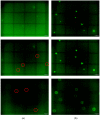An Indirect Fluorescence Microscopy Method to Assess Vaginal Lactobacillus Concentrations
- PMID: 38257941
- PMCID: PMC10820742
- DOI: 10.3390/microorganisms12010114
An Indirect Fluorescence Microscopy Method to Assess Vaginal Lactobacillus Concentrations
Abstract
Lactobacillus species are the main colonizers of the vaginal microbiota in healthy women. Their absolute quantification by culture-based methods is limited due to their fastidious growth. Flow cytometry can quantify the bacterial concentration of these bacteria but requires the acquisition of expensive equipment. More affordable non-culturable methods, such as fluorescence microscopy, are hampered by the small size of the bacteria. Herein, we developed an indirect fluorescence microscopy method to determine vaginal lactobacilli concentration by determining the correlation between surface area bacterial measurement and initial concentration of an easily cultivable bacterium (Escherichia coli) and applying it to lactobacilli fluorescence microscopy counts. In addition, vaginal lactobacilli were quantified by colony-forming units and flow cytometry in order to compare these results with the indirect method results. The colony-forming-unit values were lower than the results obtained from the other two techniques, while flow cytometry and fluorescence microscopy results agreed. Thus, our developed method was able to accurately quantify vaginal lactobacilli.
Keywords: bacterial quantification; colony forming units; flow cytometry; fluorescence microscopy; vaginal lactobacilli.
Conflict of interest statement
C.A.M. reports receiving grants to her institution from NIH/NIAID, Lupin, Abbott Molecular, Visby, and Gilead Sciences, Inc. She also reports honorarium and/or consulting fees from Scynexis, Cepheid, BioNTech, BioMed Diagnostics, Visby Medical, Elsevier, UpToDate, Abbott Molecular, and Roche. The other authors declare no conflict of interest. The funders had no role in the design of the study; in the collection, analyses, or interpretation of data; in the writing of the manuscript; or in the decision to publish the results.
Figures





Similar articles
-
Vaginal Microbiota Evaluation and Lactobacilli Quantification by qPCR in Pregnant and Non-pregnant Women: A Pilot Study.Front Cell Infect Microbiol. 2020 Jun 19;10:303. doi: 10.3389/fcimb.2020.00303. eCollection 2020. Front Cell Infect Microbiol. 2020. PMID: 32637367 Free PMC article.
-
Effectiveness of the two microorganisms Lactobacillus fermentum LF15 and Lactobacillus plantarum LP01, formulated in slow-release vaginal tablets, in women affected by bacterial vaginosis: a pilot study.J Clin Gastroenterol. 2014 Nov-Dec;48 Suppl 1:S106-12. doi: 10.1097/MCG.0000000000000226. J Clin Gastroenterol. 2014. PMID: 25291116 Clinical Trial.
-
Influence of probiotic vaginal lactobacilli on in vitro adhesion of urogenital pathogens to vaginal epithelial cells.Lett Appl Microbiol. 2006 Aug;43(2):174-80. doi: 10.1111/j.1472-765X.2006.01934.x. Lett Appl Microbiol. 2006. PMID: 16869901
-
Vaginal microbiome.Ceska Gynekol. 2018 Winter;83(5):371-379. Ceska Gynekol. 2018. PMID: 30848142 Review. English.
-
Vaginal Microbiota.Adv Exp Med Biol. 2016;902:83-93. doi: 10.1007/978-3-319-31248-4_6. Adv Exp Med Biol. 2016. PMID: 27161352 Review.
Cited by
-
A longitudinal pilot study in pre-menopausal women links cervicovaginal microbiome to CIN3 progression and recovery.Commun Biol. 2025 Jun 6;8(1):883. doi: 10.1038/s42003-025-08328-w. Commun Biol. 2025. PMID: 40481153 Free PMC article.
References
Grants and funding
LinkOut - more resources
Full Text Sources
Molecular Biology Databases

